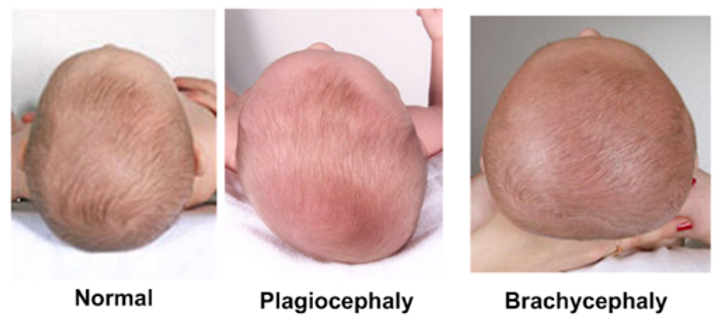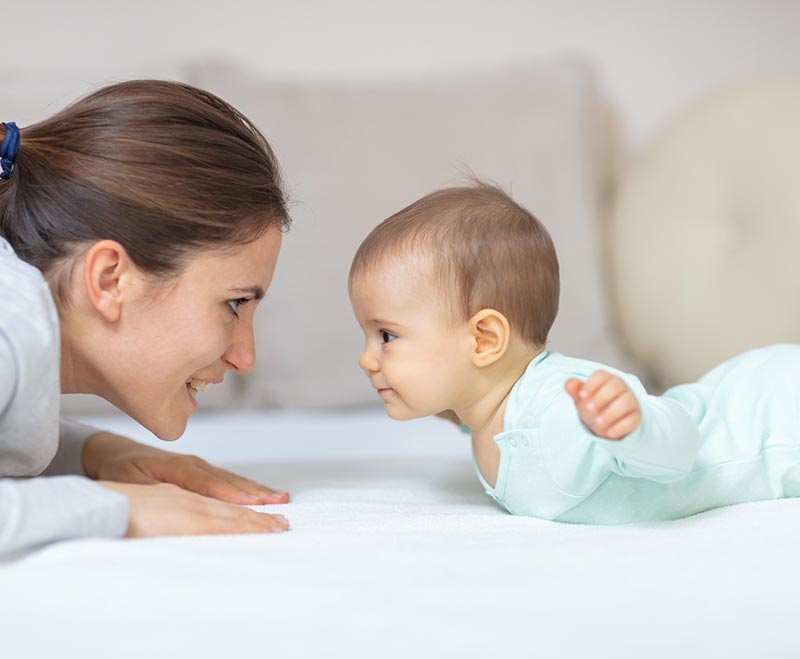There are two reasons that babies often develop a flat spot on the back of their head which is often referred to as flat head syndrome or positional plagiocephaly or deformational plagiocephaly.
- Newborn’s skull bones are extremely soft, thin and flexible, because it allows them to travel through the birth canal as well as accommodate a growing brain.
- Babies tend to have extremely weak neck muscles until three months of age. And up until this point your baby’s head will naturally fall to the side whenever they’re lying on their back.
The good news is that there are some simple things that you can do throughout your day, in regards to the way you position your baby or hold them that can actually prevent the flat spot from occurring or stop it from getting worse.
There are two different types of flattening of the baby’s head.

The first one is plagiocephaly and that is where one side of the skull is flattened and looks asymmetrical. The eyes and ears may be misaligned in severe cases. But generally, one side of the head becomes flattened, and the other side is still bulging.
Second one is brachycephaly. It is where the back of the skull is flatten. It’s on both sides that often results in the head widening, and in some severe cases, the forehead getting larger.
What Causes Flathead?
Most parents notice flattening of the skull at around six to eight weeks of age. And there 3 common causes for the flathead.
- Sleeping on their back for a long period of time, and they’re also often in car seats and strollers, there’s external force going in and applying it on that head. Because the bone is soft and thin, it may result in some flattening. However, it is still recommended that they continue to sleep on their back because it does reduce significantly the risk of sudden infant death syndrome or SIDS.

- If your baby was born prematurely or has a medical condition, then that often results in some prolonged positioning on their back, because their muscles are a bit weak, their head is naturally falling to that side and developing that flat spot.
- The other main cause is torticollis. Torticollis is the condition that your muscle which runs from the neck to the collarbones, behind their ear to their collarbone becomes really tight. And it looks like your baby’s head is tilted, the chin is going in the opposite direction. Because the side that is tight pools down, so that their head is falling to one side and their chin is going to the other direction. Now because this muscle is really tight, it is hard for them when they’re lying on their back to move their head in any other position, and they would constantly get a pressure on that side of the head that is making contact with the ground, which will then develop in that flat spot occurring.
If you do notice that your baby can’t turn their head in both directions really smoothly. When they’re lying on their back, they can’t actually turn it all the way in both directions, then I would recommend you go see your baby’s doctor who can check to see if they do have torticollis, because if you get onto it earlier, they can get some intervention from a physiotherapist, or some allied health professional who would be able to give you some exercises and activities to try and lengthen that muscle, so it’s not as tight and will prevent that flat spot from occurring in the first place or getting worse.
How to Prevent Flat Spot?
There are some strategies you can do throughout your day with your little one to try and prevent that flat spot occurring or from getting worse.
Even though the recommendation is that they continue to sleep on their back, what you can do is when your baby is asleep on their back, you can go in and just turn their heads, so that one night they might be looking to the left, and then the next night they might be looking towards the right.
The other thing you can do is think about where you’re placing the cot in their room. Babies like to look at things that are very interesting. If you place their cot in a place where it is facing a blank wall on one side, and looking out into the room on the other side, they’re going to be more likely to turn their head to look out into that room. So when you put your baby to bed, you want to change the direction they are in the cot. One night you might put your babies in the direction that their feet are down this end of the cot, and then the next night you might change it, so that your baby’s feet are down the other end of the cot. And what that does is encourage your baby to look out to the side of the room, and they’re going to have lots of interesting things to look at and that will encourage them to turn their head, and start to fall asleep on that side, which then will result in distributing the pressure through their back of their head throughout their sleep.
Also, when your baby is awake, you want to encourage lots of tummy time, because obviously that gets them off the back of their head.

The other activity you can do with your baby when they’re awake is get them to play when they’re side-lying, that’s where you roll them onto their side and you would place a toy in their line of sight. When they’re in that newborn phase, this will just help get pressure off the back of your baby’s skull.
And also you could look at changing the direction your baby’s facing, so they might do side-lying towards the left, and then the next day it’ll be towards the right. Now when your baby’s doing tummy time and side-lying, it’s really important to make sure you watch them in this position, because they can accidentally fall onto their tummy, and then they can actually clear their body from that or their head.
It’s also really good to use different ways of carrying your baby.You could use the football hall which is where they’re lying in your arms and their pressure is completely off their head. You could also put them in side-lying. And again, next time you hold them, you would put them in the other arm to put pressure on the other side. You could also get them to lie in between on your thighs.
Also if you’re holding your little one in your arms, so you’re doing that cradle position, again you would hold them in one arm one day or you could do it with each one, you could just switch each period. I find it easier to just do it in one arm on one day, and then the other arm the next day, because it gets a bit confusing you hold them this side and that encourages them to look out in this direction to see what’s going on in the world, and then it puts pressure on that side of the skull. And then you would change arms the next day and it encourages them to look out in the other direction. You could also do that with them over your shoulder again, you’d have them up over your shoulder and that would encourage them to turn their head and look this way, and there’s no pressure at all on their skull at this point. And then you change arms and they would look out in that direction.
Now if you’re feeding your baby with a bottle or formula, what you want to do is change the arm that you’re holding them. If you’re feeding them this side the next time you feed them you would rotate that arm and use the other side. And that again, would ensure that the pressure is getting distributed evenly on that skull.

If your little one is lying directly on the floor what you can do is position yourself or toys on either side of their body. In one play session you might be playing with your little one, but would be over to this side of their body and talking to them which will encourage them to look toward you, and engage in that play session. If you’re not there then I would just put some toys on this side, which again will encourage them to look at the toy. And then next play session you would sit on the other side or lay on the ground on the other side or place toys on this side, and that will encourage them to turn their head in this direction.
The other thing is when they’re playing on their back, you could also position it so that they’re got a window just beside them. And again, that would encourage them to look out the window and see the things outside. And then the next time, you would just turn their body so that they’re facing the other direction if the window was here, the first play session they might be here and then playing and underneath the play gym and then look outside this way.And then the next time he put them on the ground you would turn them around, so the window is here and that encourages them to look out in this direction.
It is recommended that you avoid letting your baby stay in car seats or baby bouncers or seats for a long period of time, because they are generally really firm surfaces that can cause flattening of the skull. The other thing is the American Academy of Pediatrics do not actually recommend the purchase of and use of baby pillows, those are the ones that have been marketed as pillows that can actually reduce the flattening of the skull occurring in babies. And that is because the pillows themselves can actually kind of cover your baby’s face, and obstruct their breathing, and also can cause overheating. And they found that when babies are placed on a pillow where their head is raised, it actually can result in their head falling forward and then their chin tucking which would then obstruct the airways and impact on their breathing.
Those are the simple things that you can do at home with your little one to try and prevent the flat spot from occurring or reduce the level of flattening. But remember, if you have any concerns about your baby’s head shape or you notice there’s flattening occurring on the back of your baby’s head, or you notice your baby can only turn their head in one direction, fully to the ground and the other one it’s slightly limited, then I would always go and see your baby’s doctor at this point to make sure that they can complete assessment, and refer you to appropriate individuals and specialists if required.

